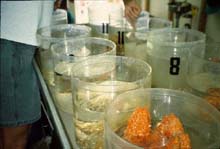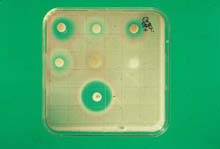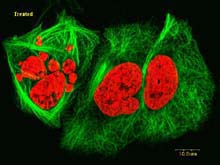
Once a dive in the submersible is completed, buckets filled with organisms are brought into the wet lab on the ship. Samples are sorted, numbered and then sub-sampled for taxonomic vouchers, microbial isolation, the "genetic ar"k and biological and chemical testing. Click image for larger view.
Biological Diversity Equals Chemical Diversity- The Search for Better Medicines
Education
Amy E. Wright, Ph.D.
Director, Division of Biomedical Marine Research
Harbor Branch Oceanographic Institution
Historically, terrestrial plants and microorganisms have been important natural sources used in the development of new medicines. In fact, approximately 75 percent of the top 20 hospital drugs (mostly antibiotics) and approximately 20 percent of the top 100 most widely prescribed drugs are derived from natural sources. Almost everyone may have used a naturally derived compound. For example, aspirin, a simple modification of salicylic acid, is derived from the bark of the willow.
Just as the rainforests can yield new drugs, the world's oceans may be an equally important resource for the discovery of new medicines. There are two reasons for this. First, the oceans cover approximately 70 percent of the earth's surface and contain an estimated 200,000 invertebrate and algal species and an unknown number of microorganisms. Second, more than 5,000 new compounds have been derived from marine organisms in the last decade alone, many of which have exciting biological properties. Currently, four marine natural products are in human clinical trials, and many more are staged to enter the final phases of clinical investigation.

An example of a antimicrobial assay using the disk diffusion assy. Samples are adsorbed onto a paper disk and put onto agar which is seeded with the bacteria. The plate is grown up for 24 hours. If an extract is active, there will be a clear circle around the paper disk where no bacteria is growing. The three extracts on the top row are all active. Click image for larger view.
This diversity of chemical compounds is thought to be the result of extreme competition between organisms for space and resources in most marine habitats. Even a cursory examination of a coral reef habitat reveals a high density of plants and animals. The space available for continued growth and colonization is limited, and therefore, many sedentary marine organisms have developed a diverse array of chemical compounds known as "secondary metabolites" or "natural products," which allow them to better compete for resources.
A multidisciplinary team approach is required to discover marine natural products with potential as therapeutic agents. The Harbor Branch Oceanographic Institution (HBOI) team consists of scientists from a number of disciplines, including: marine biologists and microbiologists that collect, document and identify the organisms to be studied; immunologists, tumor biologists, microbiologists, virologists and biochemists that evaluate potential drug targets and design appropriate models for testing extracts and compounds present in the organisms collected; natural products chemists that purify and determine the structures of the active principles present in the marine organisms; and cell biologists, aquaculturists, molecular biologists and synthetic chemists that provide a sustainable supply of active compounds.
Sample Acquisition
The sample acquisition team is responsible for collecting and identifying macroorganisms to evaluate their potential biological activities. On this expedition, we will focus on the collection of sponges, cnidarians, and tunicates and the microorganisms that live inside these organisms. Our sample acquisition group also will be isolating the microorganisms that live within the tissues of the invertebrates. Like their terrestrial counterparts, these organisms provide an excellent opportunity for the discovery of new drugs. All samples will be photographed, and small pieces will be removed as voucher specimens, which will allow us to document the collections. Our molecular biologists also will store tissues of each organism to create a "genetic ark," which will allow for follow-up investigations of especially exciting new species. The DNA present in these organisms can be used both to identify the species as well as to help provide a long-term source of compounds.

Discodermolide was isolated from the sponge Discodermia dissoluta. This compound is a potent antitumor agent and may become an important new weapon in the fight against cancer. Photo: Harbor Branch Oceanographic Institution
Biological Evaluation
A major challenge in current chemotherapy is that many cancers and bacteria can become resistant to drug therapy. Our current focus is on finding compounds that will treat these multidrug resistant (MDR) cells. Thus, the biological evaluation program tests the extracts of the organisms we collect to determine if they can kill cancer cells, bacteria or fungi. On shipboard, we will run simple antimicrobial assays to determine bioactivity. When we return to our laboratory at HBOI, we will use our robotics systems to rapidly test the compounds through a series of bioassays. Extracts also will be sent to partners in the pharmaceutical industry. There they will be tested through many more assays and evaluated for utility in a broader range of diseases (e.g., AIDS, heart disease, arthritis, asthma, etc.).

Confocal images of human lung cancer cells not treated with drugs. The green is the microtubule network (part of the cell cytoskeleton) stained with an antibody to tubulin. The red is the nucleus stained with propidium iodide. Click image for larger view.
Natural Products Chemistry
Biologically active compounds display a wide range of complexity and structural types. An extract of a marine organism typically contains many different compounds, only one of which is responsible for the bioactivity. The active compounds are purified using a combination of chromatographic methods including: thin layer, open column, vacuum column, centrifugal counter current and high performance liquid chromatographies (HPLC). "Bioassay guided fractionation," a process whereby each fraction from a chromatographic separation is tested in the target assay prior to further purification, is used to ensure that the bioactive compounds are isolated. Once pure compounds are isolated, their structures are determined using nuclear magnetic resonance, infrared, ultraviolet and mass spectroscopies.
On shipboard we will use HPLC to look at each of the extracts. Ones that look especially rich in chemistry will be targeted for recollection.
After the original discovery phase, compounds are developed in cooperation with either industrial partners or with the National Institutes of Health. To fully evaluate the clinical usefulness of the compounds, we must have large quantities of the compounds. To alleviate the need to continually collect wild organisms, we are working to develop methods for invertebrate cell culture, aquaculture and recombinant production.

Confocal images of human lung cancer cells treated with discodermolide. Note the extreme rearrangement of the microtubule network and the break down of the cell nucleus. This rearrangement is irreversible and blocks the cell from dividing, and thus eventually leading to cell death. Click image for larger view.
What are the results of this research to date?
Over the past ten years, HBOI's Division of Biomedical Marine Research has discovered over 300 bioactive compounds and has filed over 100 patents describing their bioactivities. Two of our most exciting discoveries have been the discodermolide and the topsentin series of compounds. Discodermolide, a substance isolated from the deep water sponge Discodermia polydiscus, is a potent antitumor agent. It works in a manner similar to the drug Taxol, but it also has shown improved ability to fight against multidrug resistant tumors. Topsentin, a substance from the deep water sponge Spongosorites ruetzleri has potent anti-inflammatory properties and may be useful in treating arthritis and skin irritations. Topsentin also may be useful in protecting against colon cancer and Alzheimer’s disease as well as treating inflammatory bowel disease. No explorations for new medicines have been conducted in the South Atlantic Bight before now, and we are optimistic about finding many new organisms.
The Lesson plans developed for this Web site are available in the Education Section.
Sign up for the Ocean Explorer E-mail Update List.














































